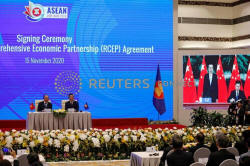Explainer: What happens now the RCEP trade deal has been signed?
 Send a link to a friend
Send a link to a friend
 [November 16, 2020] By
James Pearson [November 16, 2020] By
James Pearson
HANOI (Reuters) - Fifteen Asia-Pacific
economies signed what could become the world's largest free trade
agreement on Sunday, covering nearly a third of the global population
and about 30% of its global gross domestic product.
The Regional Comprehensive Economic Partnership (RCEP) will
progressively lower tariffs and aims to counter protectionism, boost
investment and allow freer movement of goods within the region.
WHO HAS SIGNED?
RCEP includes China, Japan, South Korea, Australia, New Zealand and the
10 members of the Association of South East Asian Nations (ASEAN):
Brunei, Vietnam, Laos, Cambodia, Thailand, Myanmar, Malaysia, Singapore,
Indonesia and the Philippines.
India was involved in early discussions but opted out last year over
concerns related to cheap Chinese imports.
Member states have said there is still room for India to join RCEP,
however. Anyone can join RCEP 18 months after it comes into force but
India, as one of the original negotiating partners, can join at any time
once the deal comes into effect.

WHAT HAPPENS NEXT?
RCEP was signed at the end of a four-day ASEAN summit in Hanoi on Sunday
and must now be ratified before coming into effect, a process that will
take months to start and years to complete.
The 510-page, twenty-chapter agreement was not made public before
Sunday's ceremony because "a number of parties would not consent to the
release of the text prior to signature", New Zealand's foreign ministry
said in a statement.
According to copies of the agreement uploaded to the foreign ministry
websites of RCEP member states on Sunday, the deal must be ratified by
at least six ASEAN countries and three non-ASEAN signatory countries
before it can come into effect.
EAST ASIAN RIVALRY
Notably, RCEP marks the first time China, Japan and South Korea have
been brought together under a single trade agreement - a process that
has been otherwise marred by historical and diplomatic disputes.
Last year, at the height of a trade dispute between Japan and South
Korea, which had its roots in a dispute stemming from Japan's wartime
colonisation of the Korean peninsula, South Korean officials said
Japanese trade restrictions violated the "spirit" of the RCEP.
"Japan may find significant benefits (with RCEP), as it now has
preferential access to South Korea and China, which it did not have,"
said Deborah Elms of the Singapore-based Asian Trade Centre.

[to top of second column] |

Vietnam's Prime Minister Nguyen Xuan Phuc (L) sits next to Minister
of Industry and Trade Tran Tuan Anh as they watch a screen showing
Chinese Minister of Commerce Zhong Shan (R) signing next to Chinese
Premier Li Keqiang during the virtual signing ceremony of the
Regional Comprehensive Economic Partnership (RCEP) Agreement during
the 37th ASEAN Summit in Hanoi, Vietnam November 15, 2020. REUTERS/Kham

WHEN WILL IT KICK IN?
RCEP provides some flexibility for less-developed members to implement
the practical and legislative changes it requires. Cambodia and Laos,
for example, have three to five years to upgrade customs procedures.
Specifically which areas are open to tariff reductions under RCEP is
complex and changes from country to country. Some states have listed
what RCEP includes, others have listed what it does not.
For countries which already have free trade agreements with each other,
an added benefit of RCEP is that it creates a common set of rules of
origin, which will facilitate easier movement of goods between the 15
members.
HOW DOES RCEP COMPARE WITH CPTPP?
The idea of RCEP, hatched in 2012, was seen as a way for China, the
region's biggest importer and exporter, to counter growing U.S.
influence in the Asia-Pacific. It gained momentum when Trump withdrew
the United States from the Trans-Pacific Partnership (TPP) in 2017.
The TPP has since been renamed the Comprehensive and Progressive
Agreement for Trans-Pacific Partnership (CPTPP) and it includes seven
RCEP members, but not the United States.
RCEP focuses heavily on cutting tariffs and increasing market access but
is seen as less comprehensive than the CPTPP.
It also requires fewer political or economic concessions and has less
emphasis on labour rights, environmental and intellectual property
protections and dispute resolution mechanisms.

RCEP's market size is nearly five times greater than that of the CPTPP,
with almost double its annual trade value and combined gross domestic
product.
"For an a agreement signed with countries that did not volunteer to
participate and with such incredibly diverse membership, the quality of
RCEP actually exceeds expectations," said Elms at the Asian Trade
Centre.
"It will deliver significant economic benefits to many firms."
(Reporting by James Pearson; Additional reporting by Khanh Vu in Hanoi
and Hyonhee Shin in Seoul; Editing by Robert Birsel)
[© 2020 Thomson Reuters. All rights
reserved.] Copyright 2020 Reuters. All rights reserved. This material may not be published,
broadcast, rewritten or redistributed.
Thompson Reuters is solely responsible for this content. |